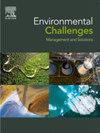Investigating soil erosion processes from source-to-sink to prioritise erosion hotspots in the Ethiopian highlands
Q2 Environmental Science
引用次数: 0
Abstract
Addressing the adverse impacts of soil erosion through effective soil conservation measures (SDG15) requires a thorough understanding of the erosion processes involved. However, existing erosion prediction models are often compared solely to sediment outflow at catchment outlets without explicitly assessing these various processes. In such cases, the observed and simulated rates at the outlet may align well without effectively showing the spatial sediment redistribution patterns in the catchment. Moreover, data availability is often limited for remote catchments. This study combined the less data-intensive Unit Stream Power Erosion Deposition (USPED) model with gully erosion indices to analyse sediment redistribution and to identify erosion hotspots in a data-scarce catchment in the Ethiopian highland. The model performance was evaluated spatially at three scales, each characterised by distinct erosion processes. The main findings indicate that the model displayed overall agreement across the three scales (R² = 0.63, NSE = 0.40, KGE = 0.47, Pbias = 5 %, RMSE = 1.39 t ha⁻¹ yr⁻¹). The catchment experienced an average soil erosion of 32.3 t ha⁻¹ yr⁻¹ from 2000 to 2023, resulting in a total annual loss of 0.32 million tons. The most erosion-prone areas, which comprise just 18 % of the catchment area, contributed approximately 69 % of the total soil erosion. The observed erosion processes vary by scale, emphasising the need for scale-aware modelling, with distinct erosion processes involved. In conclusion, the USPED model, combined with gully erosion indices, effectively captures the dominant erosion processes at various scales and identifies hotspots for targeted conservation amid land use changes.
调查埃塞俄比亚高地从源头到汇的土壤侵蚀过程,以确定侵蚀热点的优先顺序
通过有效的土壤保持措施(SDG15)解决土壤侵蚀的不利影响需要对所涉及的侵蚀过程有透彻的了解。然而,现有的侵蚀预测模型往往只与汇水口的泥沙流出量进行比较,而没有明确评估这些不同的过程。在这种情况下,在出口观测和模拟的速率可能很好地一致,但没有有效地显示流域沉积物的空间再分布模式。此外,偏远地区的数据可用性往往有限。本研究将数据较少的单位流功率侵蚀沉积(USPED)模型与沟沟侵蚀指数相结合,分析了沉积物再分布,并确定了埃塞俄比亚高原数据稀缺集水区的侵蚀热点。模型的性能在三个尺度上进行了空间评价,每个尺度都有不同的侵蚀过程。主要发现表明,该模型在三个尺度上显示出总体上的一致性(R²= 0.63,NSE = 0.40, KGE = 0.47, Pbias = 5%, RMSE = 1.39(1⁻¹yr))。从2000年到2023年,该流域的平均土壤侵蚀量为32.3吨/公顷(⁻¹yr),每年损失32万吨。最易受侵蚀的地区仅占流域面积的18%,却造成了约69%的土壤侵蚀。观察到的侵蚀过程因尺度而异,强调需要有尺度意识的模型,涉及不同的侵蚀过程。综上所述,USPED模型结合沟壑区侵蚀指数,有效地捕捉了不同尺度下的优势侵蚀过程,识别了土地利用变化中有针对性的保护热点。
本文章由计算机程序翻译,如有差异,请以英文原文为准。
求助全文
约1分钟内获得全文
求助全文
来源期刊

Environmental Challenges
Environmental Science-Environmental Engineering
CiteScore
8.00
自引率
0.00%
发文量
249
审稿时长
8 weeks
 求助内容:
求助内容: 应助结果提醒方式:
应助结果提醒方式:


